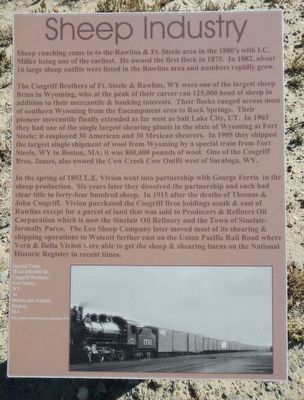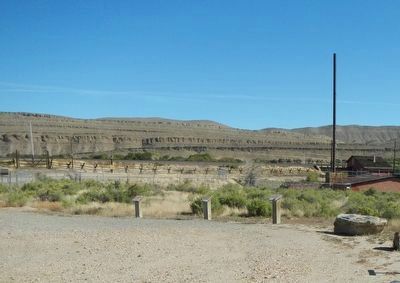Near Sinclair in Carbon County, Wyoming — The American West (Mountains)
Sheep Industry
Inscription.
Sheep ranching came in to the Rawlins & Ft. Steele area in the 1880's with I.C. Miller being one of the earliest. He owned the first flock in 1875. In 1882, about 16 large sheep outfits were listed in the Rawlins area and numbers rapidly grew.
The Cosgriff Brothers of Ft. Steele & Rawlins, WY were one of the largest sheep firms in Wyoming, who at the peak of their career ran 125,000 head of sheep in addition to their mercantile & banking interests. Their flocks ranged across most of southern Wyoming from the Encampment area to Rock Springs. Their pioneer mercantile finally extended as far west as Salt Lake City, UT. In 1903 they had one of the single largest shearing plants in the state of Wyoming at Fort Steele; it employed 30 American and 30 Mexican shearers. In 1905 they shipped the largest single shipment of wool from Wyoming by special train from Fort Steele. WY to Boston, MA; it was 800,000 pounds of wool. One of the Cosgriff Bros, James, also owned the Cow Creek Outfit west of Saratoga, WY.
In the spring of 1892, L.W. Vivion went into partnership with George Ferris in sheep production. Six years later they dissolved the partnership and each had clear title to forty-four hundred sheep. In 1915 after the deaths of Thomas & John Cosgriff, Vivion purchased the Cosgriff Bros holdings south & east of Rawlins except for a parcel of land that was sold to Producers & Refiners Oil Corporation which is now the Sinclair Oil Refinery and the Town of Sinclair - formally Parco. The Leo Sheep Company later moved most of its shearing & shipping operations to Wolcott further east on the Union Pacific Rail Road where Vern & Della Vivion were able to get the sheep & shearing barns on the National Historic Register in recent times.
Erected by Wyoming Recreation Commission.
Topics. This historical marker is listed in this topic list: Industry & Commerce.
Location. 41° 46.567′ N, 106° 56.795′ W. Marker is near Sinclair, Wyoming, in Carbon County. Marker is on Route 347 near Interstate 80, on the right. Touch for map. Marker is in this post office area: Sinclair WY 82334, United States of America. Touch for directions.
Other nearby markers. At least 8 other markers are within walking distance of this marker. Sheep Ranching (here, next to this marker); Ranching (here, next to this marker); Sheepherder's Community (a few steps from this marker); Bridge Tender's House (about 400 feet away, measured in a direct line); Railroad and River (about 400 feet away); Brownsville and Benton (about 400 feet away); Carbon Timber Company (about 400 feet away); A Well Traveled Sawmill (about 400 feet away). Touch for a list and map of all markers in Sinclair.
More about this marker. This marker, among a grouping of a four markers, is located at Fort Fred Steele State Historic Site. The markers are on County Road 347, north of the Interstate 80 Exit 228 and south of the railroad tracks.
Also see . . .
1. The Wyoming Sheep Business - Wyoming Historical Society. Sheep ranching in Wyoming or the West simply never earned the same cachet as running cattle. When historian Frederick Jackson Turner... describes "the progression of civilization” marching past Cumberland Gap, he mentions “buffalo following the trail to the salt springs, the Indian, the fur-trader and hunter, the cattle-raiser, the pioneer farmer”—but doesn’t say a word about sheep. Still, many a savvy 19th century Wyoming flockmaster made a great deal of money in the wool, lamb and mutton business. (Submitted on October 26, 2015, by Barry Swackhamer of Brentwood, California.)
2. Sheep Industry - Wyoming Tale and Trails. Although in the popular mind Wyoming is mostly associated with cattle... the impact of the "Great Die Off"... was an increased emphasis on a change from cattle to sheep. Even the Two Bar made the change. This is not to say, however, that sheep did not have an importance before 1886. (Submitted on October 26, 2015, by Barry Swackhamer of Brentwood, California.)
Credits. This page was last revised on June 16, 2016. It was originally submitted on October 26, 2015, by Barry Swackhamer of Brentwood, California. This page has been viewed 536 times since then and 63 times this year. Photos: 1, 2. submitted on October 26, 2015, by Barry Swackhamer of Brentwood, California.

